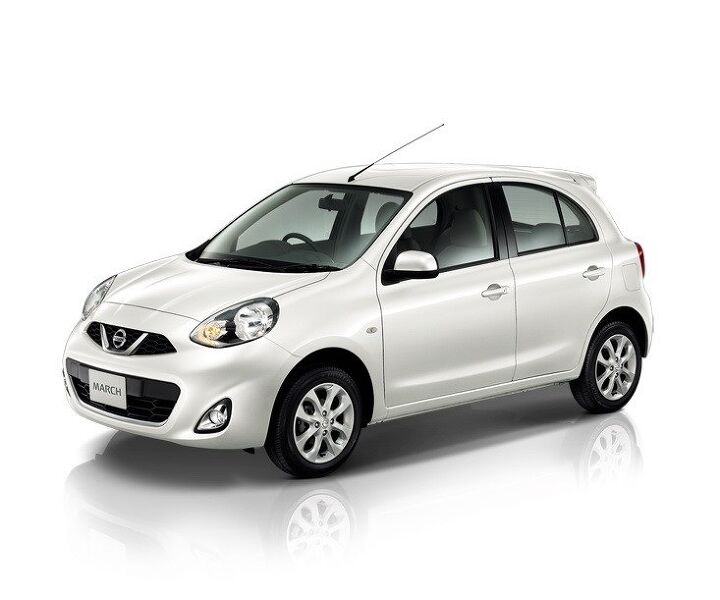Nissan Micra Solves Renault's Labor Problems

Folks who are not intimately familiar with the peculiarities of the European auto industry often call Renault a similar basket case as its French rival Peugeot. January through March, both are down in Europe, PSA (-15.3 percent) more than Renault (-8.3 percent), but the big difference is that Renault has a much wider international footprint. What’s more, Renault owns 44.3 percent of Nissan. This international footprint helps Renault solve problems in ways Peugeot can’t touch. For instance, by making Nissans.
In a statement, Nissan announced “that the replacement for the current Nissan Micra compact car will be manufactured at a Renault plant in Europe.” Of course, the official reason is not that Nissan comes to the aid of Renault, and helps it to solve its labor problems. Officially, “available capacity across the relevant plants in the Nissan manufacturing network is already planned to be fully utilized and led the company to look at alternatives within the Renault-Nissan Alliance.” Again, Peugeot PSA would love to have a partner that doesn’t know where to make all the cars it sells. PSA only has ailing Opel.
Starting in 2016, the Micra (in some markets sold as March) will be built at Renault’s plant in Flins near Paris. The Flins factory currently builds the Clio , which shares a platform with the Micra. “The next-generation Micra will share even more parts with the Clio,” Automotive News [sub] learned from French newspaper Les Echos.
With the move, the Micra will come back home to Europe, so to speak. In 2010, Micra production moved from Nissan’s Sunderland, England, plant to Chennai, in India. Nissan’s statement says that the Micra made in France “will be exported across Europe’s left-hand drive markets.” Meaning the large part of Europe where they drive on the right. The RHD cars built for driving on the left will continue to be built in India.

Bertel Schmitt comes back to journalism after taking a 35 year break in advertising and marketing. He ran and owned advertising agencies in Duesseldorf, Germany, and New York City. Volkswagen A.G. was Bertel's most important corporate account. Schmitt's advertising and marketing career touched many corners of the industry with a special focus on automotive products and services. Since 2004, he lives in Japan and China with his wife <a href="http://www.tomokoandbertel.com"> Tomoko </a>. Bertel Schmitt is a founding board member of the <a href="http://www.offshoresuperseries.com"> Offshore Super Series </a>, an American offshore powerboat racing organization. He is co-owner of the racing team Typhoon.
More by Bertel Schmitt
Latest Car Reviews
Read moreLatest Product Reviews
Read moreRecent Comments
- Dartman https://apnews.com/article/artificial-intelligence-fighter-jets-air-force-6a1100c96a73ca9b7f41cbd6a2753fdaAutonomous/Ai is here now. The question is implementation and acceptance.
- FreedMike If Dodge were smart - and I don't think they are - they'd spend their money refreshing and reworking the Durango (which I think is entering model year 3,221), versus going down the same "stuff 'em full of motor and give 'em cool new paint options" path. That's the approach they used with the Charger and Challenger, and both those models are dead. The Durango is still a strong product in a strong market; why not keep it fresher?
- Bill Wade I was driving a new Subaru a few weeks ago on I-10 near Tucson and it suddenly decided to slam on the brakes from a tumbleweed blowing across the highway. I just about had a heart attack while it nearly threw my mom through the windshield and dumped our grocery bags all over the place. It seems like a bad idea to me, the tech isn't ready.
- FreedMike I don't get the business case for these plug-in hybrid Jeep off roaders. They're a LOT more expensive (almost fourteen grand for the four-door Wrangler) and still get lousy MPG. They're certainly quick, but the last thing the Wrangler - one of the most obtuse-handling vehicles you can buy - needs is MOOOAAAARRRR POWER. In my neck of the woods, where off-road vehicles are big, the only 4Xe models I see of the wrangler wear fleet (rental) plates. What's the point? Wrangler sales have taken a massive plunge the last few years - why doesn't Jeep focus on affordability and value versus tech that only a very small part of its' buyer base would appreciate?
- Bill Wade I think about my dealer who was clueless about uConnect updates and still can't fix station presets disappearing and the manufacturers want me to trust them and their dealers to address any self driving concerns when they can't fix a simple radio?Right.


































Comments
Join the conversation
For anyone interested, you can go nuts reading on the web about the reasons why some countries drive on the left, some on the right. Crackpot theories abound. But it does look like the Brits mandated driving on the left from 1835, and the French decided to do the opposite, as usual. And the US did the same as France. Virtually all early US cars had steering wheels on the right, but traffic drove on the right too. Sweden was that way until 1964. The Model T was the first US car to have LHD, all previous Fords were RHD. Gradually the other US manufacturers changed to LHD and by 1920 or so, all had changed. Who really cares? It is what it is. Now why are most power boats still RHD? Why are virtually all US road racing circuits clockwise, favoring RHD? Only the Shadow knows. Or really cares.
Nissan Micra Solves Renaut's Labor Problems: By way of future layoffs owing to a Micra-sized profit margin. Looks like a cross between previous gen Accent and a 500.